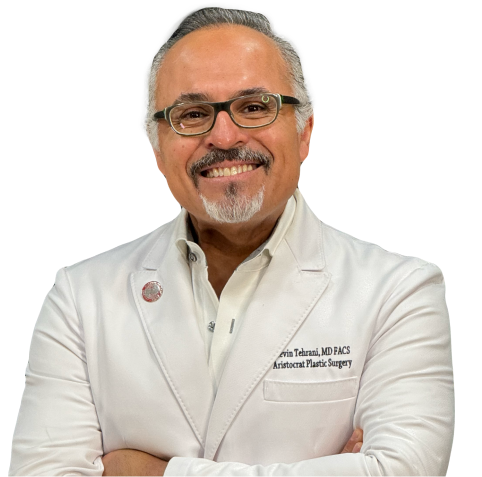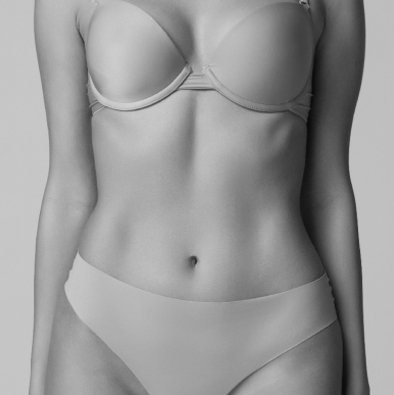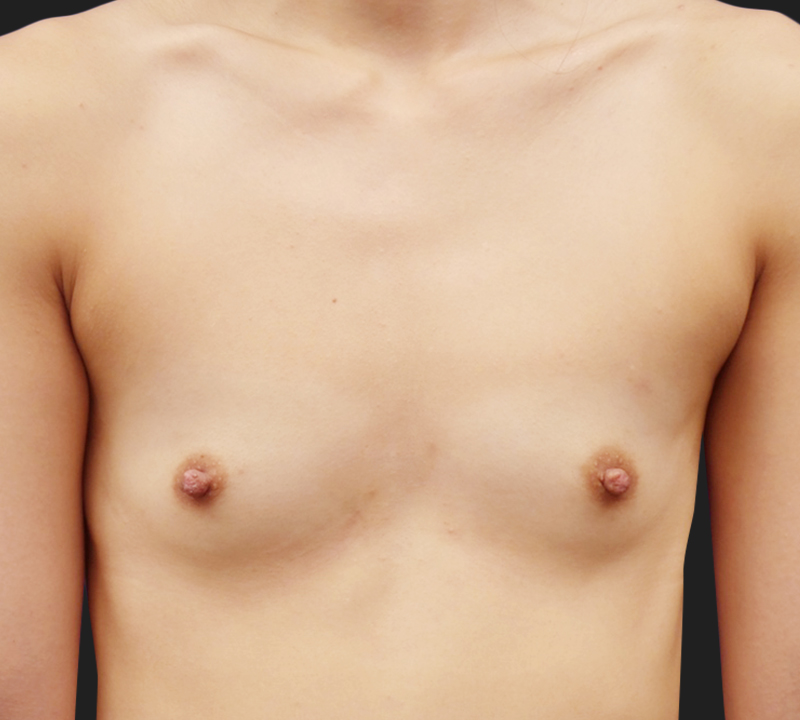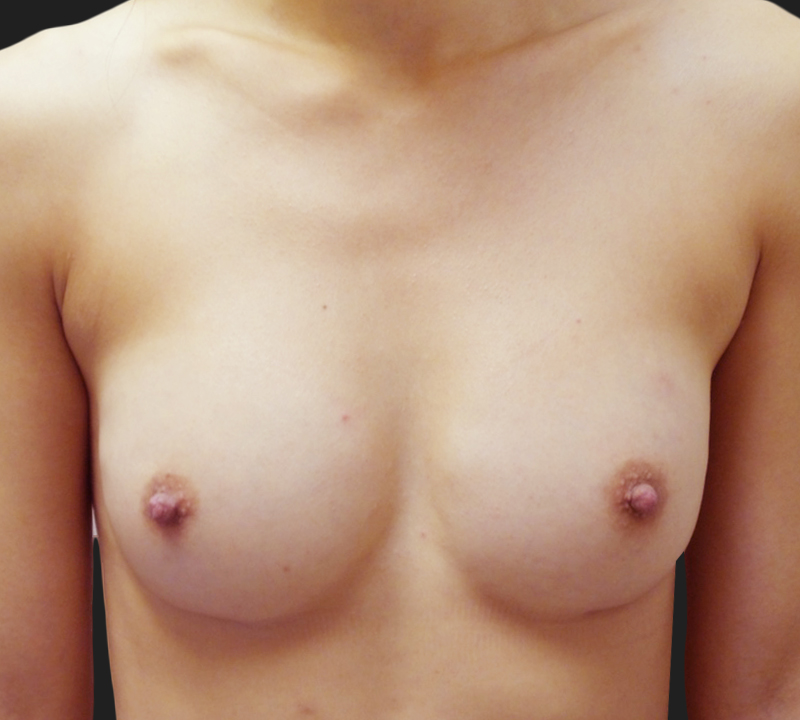Silicone Breast Implants

Are Silicone Breast Implants Right For You?
Breast augmentation with silicone implants is one of the most popular procedures Dr. Kevin Tehrani performs at Aristocrat Plastic Surgery & MedAesthetics. Silicone implants come in various shapes and sizes and consist of silicone gel and case. Silicone is a synthetic material that feels similar to human fat, that’s why silicone implants feel so soft and natural when used for breast augmentation. Famous “gummy bear implants” are highly cohesive silicone gel implants. They are known to retain their shape better than other implants.
Deciding whether silicone breast implants are the right choice for you involves careful consideration of several factors. First, consult with a board-certified plastic surgeon such as Dr. Tehrani to discuss your goals, expectations, and medical history. Assess your motivations for the procedure, ensuring they are personal and not influenced by external pressures. Evaluate the potential risks and complications associated with silicone implants, such as rupture or capsular contracture. Consider your lifestyle and the long-term commitment to follow-up appointments for monitoring. Lastly, weigh the emotional and physical impact and the financial cost. Ultimately, a thorough consultation with Dr. Tehrani will help you make an informed decision about silicone breast implants.
read more

More About Silicone Breast Implants
After having breast augmentation with silicone implants, it’s very important and an FDA recommendation to get an MRI screening every few years to make sure that implants are in the correct position and there is no rupture. Leaking silicone gel is not linked to any health problems, but may cause discomfort in some patients. In the unlikely scenario that a rupture happens, Dr. Tehrani can perform implant removal or implant exchange.
Breast implants can be inserted through several approaches. The vast majority of breast augmentations and breast revisions done at Aristocrat Plastic Surgery are via the inframammary incision. Other approaches include transaxillary (through the armpit), transumbilical, or periareolar methods.
read more

Types of Breast Augmentation Procedures
Transumbilical Breast Augmentation
Transumbilical Breast Augmentation (TUBA) is the breast augmentation technique when breast implants are placed through an incision in the belly button, leaving no visible scars on the body. This method of breast augmentation is associated with minimal pain and a faster recovery.
Here's an overview of the steps involved in a Transumbilical Breast Augmentation:
- Preparation: Before the surgery, the patient discusses their goals and preferences with Dr. Tehrani. This includes selecting the appropriate implant size, shape, and placement.
- Anesthesia: The patient is typically placed under general anesthesia to ensure comfort and pain control throughout the procedure.
- Incision: A small incision is made within the navel (belly button), hiding any potential scarring within the natural creases of the belly button. Unlike other breast augmentation techniques, TUBA does not require incisions on or around the breast area.
- Implant insertion: A specialized instrument called a cannula is used to create a tunnel from the navel incision to the breast area. The empty saline implant is rolled up, inserted through the tunnel, and then filled with sterile saline solution once it's properly positioned in the breast pocket. This allows for minimal scarring and no visible breast incisions.
- Adjustment and evaluation: Dr. Tehrani carefully assesses the symmetry and positioning of the implants to ensure they align with the patient's aesthetic goals.
- Closure: After the implants are in place, the navel incision is closed with sutures, and a small bandage is applied.
- Recovery: Patients may experience mild discomfort, swelling, and bruising after the procedure, which typically subsides over a few days. Patients are advised to avoid strenuous activities and follow post-operative instructions provided by Dr. Tehrani.
While TUBA offers minimal scarring and a quicker recovery compared to other breast augmentation methods, it is not suitable for everyone. Ideal candidates are those seeking modest breast size increases and are comfortable with saline implants. Each patient's suitability for TUBA should be discussed thoroughly during consultation with Dr. Tehrani to determine the most appropriate approach for their unique needs and goals.
read more
Shaped Implants
Shaped silicone breast implants are also known as “Teardrop” implants. Unlike smooth round implants, these implants are shaped like a teardrop (thinner at the top than the bottom) and are designed to provide a better projection of the breasts.
Here's an overview of a procedure involving shaped implants:
- Consultation: The process begins with a consultation with Dr. Tehrani. During this meeting, the patient discusses their goals, desires, and any concerns related to breast augmentation. Dr. Tehrani evaluates the patient's anatomy, tissue characteristics, and chest dimensions to determine the appropriate implant size, shape, and placement.
- Anesthesia: On the day of the surgery, the patient is placed under general anesthesia or, in some cases, local anesthesia with sedation to ensure comfort during the procedure.
- Incision: Dr. Tehrani makes an incision in one of several possible locations, such as:
- Inframammary: Underneath the breast crease.
- Periareolar: Around the edge of the areola.
- Transaxillary: In the armpit.
- Transumbilical (TUBA): Through the navel (less common for shaped implants).
- Pocket Creation: After the incision is made, Dr. Tehrani creates a pocket either above or below the chest muscle (pectoralis major). The choice of pocket placement depends on the patient's anatomy and implant characteristics.
- Shaped Implant Placement: Dr. Tehrani carefully inserts the shaped implant into the pocket. Unlike round implants, shaped implants have a specific orientation and are designed to align with the natural slope of the breast. Dr. Tehrani will ensure that the implant is correctly positioned to achieve the desired breast shape and projection.
- Suture and Closure: Once the implant is in place, the incisions are closed with dissolvable sutures or sutures that will need removal in a follow-up appointment. Sterile dressings and bandages are applied to protect the incision sites.
- Recovery: After the procedure, patients typically experience some swelling, bruising, and discomfort, which gradually subsides over a few weeks. It's essential to follow the post-operative care instructions provided by Dr. Tehrani, which may include wearing a supportive bra, avoiding strenuous activities, and attending follow-up appointments for monitoring.
Shaped implants are often favored when patients desire a more natural-looking breast contour with a tapered upper pole and increased fullness in the lower portion of the breast. However, the use of shaped implants requires careful planning and precise surgical techniques to achieve optimal results. Patients should discuss their options and expectations with Dr. Tehrani to determine the best approach for their personal goals.
read more
Anatomical Implants
Anatomical implants are contoured rather than round, fuller on the bottom/base and less full on the top like the anatomical shape of the natural breast. This is sometimes called “teardrop shape.” Originally, these implants were used for breast reconstruction
after a mastectomy, but it became obvious that many women would prefer them for cosmetic breast augmentation as well.
Here's a description of a typical procedure involving anatomical implants:
- Initial Consultation: The process begins with a comprehensive consultation with Aristocrat’s board-certified plastic surgeon, Dr. Tehrani. During this consultation, the patient discusses their cosmetic goals, preferences, and any concerns related to breast augmentation. Dr. Tehrani evaluates the patient's anatomy, breast size, and chest dimensions to determine the appropriate implant size, shape, and placement.
- Anesthesia: On the day of the surgery, the patient is placed under either general anesthesia or, in some cases, local anesthesia with sedation. This ensures the patient's comfort and pain control during the procedure.
- Incision: Dr. Tehrani makes an incision in one of several possible locations, depending on the patient's preferences and anatomy. Common incision sites include:
- Inframammary: Underneath the breast crease.
- Periareolar: Around the edge of the areola.
- Transaxillary: In the armpit.
- Transumbilical (TUBA): Through the navel (less common for anatomical implants).
- Pocket Creation: After making the incision, Dr. Tehrani creates a surgical pocket either above or below the chest muscle (pectoralis major). The choice of pocket placement is determined based on the patient's anatomy and Dr. Tehrani’s recommendations.
- Anatomical Implant Placement: Dr. Tehrani carefully inserts the anatomical implant into the pocket. Unlike round implants, anatomical implants have a specific orientation and are designed to closely mimic the natural slope and contour of the breast. Dr. Tehrani ensures that the implant is positioned correctly to achieve the desired breast shape and projection.
- Suture and Closure: Once the implant is in place, the incisions are meticulously closed with dissolvable sutures or sutures that will need to be removed during a follow-up appointment. Sterile dressings and bandages are applied to protect the incision sites.
- Recovery: After the procedure, patients may experience some swelling, bruising, and discomfort, which typically subsides gradually over several weeks. It's essential for patients to follow the post-operative care instructions provided by Dr. Tehrani, which may include wearing a supportive bra, avoiding strenuous activities, and attending follow-up appointments for monitoring.
Anatomical implants are often favored when patients desire a breast augmentation with a more natural-looking contour, especially in cases where a tapered upper pole and increased fullness in the lower portion of the breast are desired. However, the use of anatomical implants requires precise surgical planning and technique to achieve the desired results. Patients should thoroughly discuss their options and expectations with their surgeon to determine the best approach for their specific goals.
read more

Meet Dr. Kevin Tehrani, MD FACS
Get in touch
To schedule a consultation, please fill out the form below or call us at our Manhattan or Great Neck office locations.
"*" indicates required fields
Frequently
Asked Questions
What makes silicone implants different from saline?
They’re filled with cohesive silicone gel, often providing a more natural feel and shape.
Are silicone implants safe?
Yes. They’re FDA-approved and widely used. Regular follow-ups or MRIs may be recommended to detect potential ruptures.
Who typically benefits most from silicone implants?
Patients with thinner breast tissue who want a more natural feel and less rippling.
Are silicone implants heavier than saline?
They can be slightly heavier, but the weight difference is minimal and usually not noticeable.
How is a rupture detected?
Silicone ruptures can be “silent.” Routine imaging (MRI or ultrasound) helps identify issues that may not be outwardly apparent.





